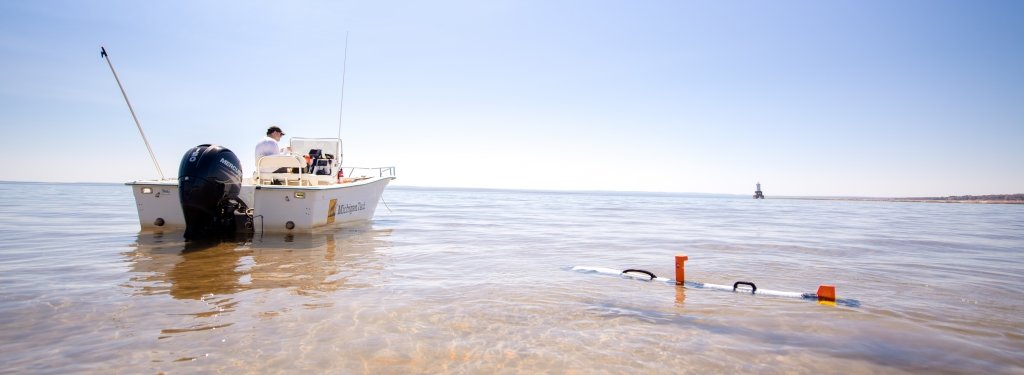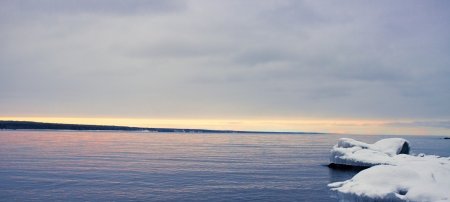Colleen Mouw double-checked to make sure the email wasn't spam. Who gets a personalized message from the White House anyway? The correspondence was indeed real—and an early step to Mouw winning one of the prestigious Presidential Early Career Awards for Scientists and Engineers (PECASE) this spring.
PECASE Award Winner Colleen Mouw
Mouw has helped bring oceanography to the Great Lakes for which the National Aeronautics and Space Administration (NASA) nominated her for the PECASE Award. She will be in Washington, D.C. during early May.
Specializing in remote sensing, Mouw is an assistant professor of oceanography in the Department of Geological and Mining Engineering and Sciences at Michigan Technological University and a scientist in the Great Lakes Research Center. Mouw's work focuses on the big picture of some of the world's smallest life forms.
"I've done quite a bit of work determining phytoplankton functional types from space," she says, explaining photosynthesizing free-floating plants that make up the bottom of the food chain produce nearly half of the world's oxygen and affect global carbon and nutrient cycles.
By connecting the world's smallest and largest scales, Mouw hopes to help grow understanding of how aquatic ecosystems are responding to environmental change and what this means for water resources that people rely on in the Great Lakes and around the globe.
For her innovative work, Sen. Gary Peters joins in congratulating Mouw on her award, which he says is a true testament to her commitment to marine science and pursuit of innovative research.
"Mouw's efforts to keep the Great Lakes safe are profoundly benefiting the millions of Michiganders that rely on the Lakes for clean drinking water and as drivers of economic growth through tourism, recreation, shipping, and so much more."Sen. Gary Peters
The Salty Divide
Mouw says that in her research journey she has walked with two communities—people who study ocean systems and people who study lakes.
"Unfortunately, oceanography and limnology don't cross each other as much as you'd think they would," Mouw says, adding that fellow researchers have called this the "salty divide."
Mouw is bridging the divide. The Great Lakes, while freshwater, are large enough to be seas, and their physical processes affect the lives and location of phytoplankton and other organisms. To better understand these complex relationships, Mouw is using oceanography tools and techniques to improve remote sensing data for the Great Lakes.
Paula Bontempi is the NASA program manager who nominated Mouw for PECASE. She says that Mouw's contributions to oceanography—from research on ocean plants in the Bering Sea to public health issues in Wisconsin lakes—reflect her ability to link water, land and atmosphere in a complex, changing climate.
"Mouw does a superb job of putting her research in the context of the ocean’s role in the earth system and its dynamics. She has active projects at many scales, ranging from the global ocean to the Great Lakes."Paula Bontempi
There's extra motivation to gather more data as well. Unlike oceans, the National Oceanic and Atmospheric Administration reports that the lakes are a source of drinking water for about 40 million people.
Human Health and Algae Blooms
One part of Mouw's research is monitoring and analyzing toxic algae blooms. In the case of Lake Erie, there is one main culprit: the cyanobacteria Microcystis. Both satellite observations and continuous monitoring with moored sensors enables Mouw and colleagues to look at change over time along with in-water parameters. Understanding the conditions affecting Microcystis and phytoplankton communities may lead to better predictions for algae blooms.
"Being able to record continuously has truly helped us understand ecosystem processes," Mouw says.
John Gierke, Chair of the Department of Geological and Mining Engineering and Sciences at Michigan Tech, is especially appreciative of all of Mouw’s contributions to both human health and ecology.
"The PECASE recognizes Mouw as an outstanding researcher and a great scholar, who nationally sets the standard for young faculty in oceanography."John Gierke
Gierke adds that he especially admires Mouw as an effective professor who inspires undergraduate and graduate students in the program. She also co-leads a national program called Mentoring Physical Oceanographers to Increase Retention that supports early career female researchers.
As Seen from Space
Phytoplankton contain different pigments—and from a satellite's perspective that means they reflect light differently at various wavelengths. Mouw works with this reflectance data from water bodies collected by satellites. Of the light that enters a water body, reflectance is all about measuring the spectral characteristics of light radiating back. Different constituents in water scatter or absorb light, radiating back distinct spectral signals.
Additionally, the size of the phytoplankton changes that reflectance. Small phytoplankton tend to absorb light more efficiently than larger cells. These small changes in reflectance enable Mouw to identify different kinds of phytoplankton.
"We look at these microscopic cells from space and it's not just about figuring out where they are, but who is there," Mouw says.
The challenge in this work is sorting out the signal attributed to various constituents that have an optical signal. In addition to phytoplankton, Mouw also has to account for suspended sediments and colored dissolved organic matter—think how tea changes water color and the leaves might be floating in the cup.
The algae blooms in Lake Erie are a unique example because the Microcystis signal is loud (and visually very green on maps). More often, the signals from different phytoplankton are subtler, making it difficult to sort out other constituents that also contribute to the surface reflectance observed by satellites. Mouw and her students have spent a significant amount of time categorizing and labeling different reflectance signals in Lake Superior and the other Great Lakes.
“This effort has really improved our understanding of systems, such as Lake Superior, that are difficult to access in the winter due to ice cover," Mouw says.
The data comes from several satellites. Much of Mouw's historical data comes from the SeaWiFS and MODIS satellite sensors. She and her team are looking forward to expanded capability of the next generation satellite sensor, called PACE.
Mouw's PECASE Award reflects both the breadth and depth of her efforts to expand satellite observations in the Great Lakes and phytoplankton groups in the oceans.
Michigan Technological University is an R1 public research university founded in 1885 in Houghton, and is home to nearly 7,500 students from more than 60 countries around the world. Consistently ranked among the best universities in the country for return on investment, Michigan's flagship technological university offers more than 185 undergraduate and graduate degree programs in science and technology, engineering, computing, forestry, business, health professions, humanities, mathematics, social sciences, and the arts. The rural campus is situated just miles from Lake Superior in Michigan's Upper Peninsula, offering year-round opportunities for outdoor adventure.







Comments